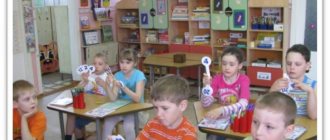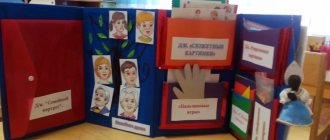MAGAZINE Preschooler.RF
Methodological development: Multifunctional didactic manual “Activities” for children of senior preschool age.Municipal autonomous preschool educational institution Kindergarten No. 30 “Golubok”
Contributing authors:
- Nemaltseva Elena Nikolaevna
- Perstenchik Tatyana Sergeevna
- Sorokina Ekaterina Alexandrovna
Osinnikovsky GO, 2021
Educational field Cognitive development
Speech development
Social and communicative development
Age category of pupils Children preschool age 4-7 years
Relevance Game is usually called the main form of activity of a preschooler. It is in play that different aspects of his personality are revealed and developed, many emotional and intellectual needs are satisfied, and the child’s character is formed. In preschool pedagogy, didactic play is considered as a multifaceted pedagogical phenomenon, which is a method of teaching preschool children, their independent play activities, and is a means of harmonious development of the child’s personality. Didactic games are based on intellectual actions associated with specific mental operations: comparison, classification, generalization, feature selection, systematic meaningful search by condition, elimination of unnecessary things, etc. The teacher’s task is to create favorable conditions for the child’s play activities. To do this, it is necessary to create didactic games and multifunctional teaching aids.
Goal, objectives Goal: Development of independence and initiative of students, cognitive interests and abilities, intellectual development based on practical actions.
Tasks:
— Acquaintance and consolidation of such concepts as time, sign, symbol, sign systems; familiarize yourself with specific signs: numbers, mathematical signs.
— Consolidate and expand acquired knowledge through practical experience, develop a desire to learn to understand time, record and determine it, and plan your actions.
— Acquaintance and strengthening of children with the operations of counting and measurement, with the need to name their results.
— To give an idea of the algorithm of counting operations, to introduce arithmetic operations, to strive to form a positive attitude towards mathematics as a science.
— Develop logical thinking, the ability to answer questions in complete sentences and enrich children’s vocabulary.
- Develop the ability to be attentive and think
show activity of thought and ingenuity.
Description
The multifunctional teaching aid “Zanimatika” is a cube with teaching material on each face.
1. Geoboard (shapes with an elastic band)
Goal: to develop children’s ability to orient themselves on a plane, to work according to a diagram, to see the connection between an object or phenomenon in the surrounding world and its abstract image, to develop logic, imagination, perseverance, and attention.
Easy to use and at the same time functional playing material allows the child to construct on a plane many different images (numbers, letters, geometric shapes, patterns, household items, animals). “Drawing with rubber bands” gives the child a unique opportunity to “feel with his fingers” the shape of geometric shapes and depicted silhouettes.
2. "Math Train"
Goal: enables children to realize the tasks of educational areas: “Physical development” , “Cognitive development” , “Artistic and aesthetic development” .
Game options:
1. Physical development
Perform any movement this many times (I show the number on the car)
2. Cognitive development.
Using “Locomotive and Wagons” and cards with numbers and signs, pictures on the topics: “Place the numbers in order” , “Which number is missing?” , “Name the next (previous) number” , “Arrange the seasons (days of the week) in order” , “Place wild animals in 1 carriage, and domestic animals in 2nd carriage” , “Place the animals of Australia in carriages. What is the number of carriages with kangaroos” , “Find neighbors”
Using “Locomotive and Carriages” and cards with numbers and signs. The teacher places cards with numbers on any window(s) of the trailer. The child needs to find the neighbors of the number or restore a sequential series of numbers by laying out the missing cards.
Examples of didactic games.
Didactic game "Composition of numbers" .
Children determine the composition of a particular number. By placing any number from 2 to 10 on the train window. By placing cards with numbers on the train windows, the child needs to determine the composition of the number. For example, we put 10 on a train, and on the windows of the carriages 1 and 9, 2 and 8, 3 and 7, etc.
Didactic game “Making up problems” .
Invite children to create a task using materials and their imagination.
For example: There were 5 little frogs sitting in the train carriage. The two frogs thought. How many happy little frogs were there? (5-2=3) There were 3 cheerful frogs sitting in the train carriage.
3. Speech development.
Using “Locomotive and carriages” and cards with pictures, letters on the topics: “Read the word syllable by syllable” , “Place words with sound [z] in 5 carriages” , “What first, what next” , “Make a story based on the picture” .
4. Artistic and aesthetic development.
Using “Locomotive and carriages” and cards with pictures on the topics: “Arrange objects in carriages by color” , “Arrange the colors of the rainbow in order” , “Select items with Dymkovo painting in the first carriage, Khokhloma painting in the second”
“Help me translate the paintings. Place portraits in the first carriage, landscapes in the second, still lifes in the third carriage." , "Little Engine Song" .
An interesting visual aid for a music director to analyze a song into parts: intro, verse 1, chorus, bridge, verse 2, chorus, bridge, verse and chorus. Please pay attention to the children that a loss is indicated by small couplings between the cars. Usually. It is difficult to explain to children what “losing” . And here everything is visible and clear
3. Houses.
Examples of didactic games.
Didactic game "Composition of numbers"
Children determine the composition of a particular number. By placing any number from 2 to 10 on the roof window. By placing cards with numbers on the house windows, the child needs to determine the composition of the number. For example, we put 8 on the roof, and on the windows of the house 1 and 7, 2 and 6, 3 and 5, etc. Attention! The number of floors will be different for different numbers.
Didactic game “Comparing objects by quantity”
Children build a house according to the sign on the roof. By placing any sign of more or less on the roof window. Putting cards with numbers on the windows of the houses. For example, we put the sign less on the roof, and on the windows of the house the number 5 is less on the opposite window of the row, the number 6, etc.
Didactic game “Making up problems”
Invite children to create a task using materials and their imagination.
4. "Carousel".
Goal: To consolidate spatial representations (above, below, right, left).
The game is designed in the form of a carousel with seats for characters (wild animals, domestic animals, etc.). The child is invited to ride the animals on the carousel, seating them correctly (for example, a squirrel on the left, a bear at the top, etc.) or place them as the child wants, but then tell who and where he placed them.
5. "Fun Alphabet"
Goal: to develop children’s ability to choose a picture whose name contains a specific letter.
There are pictures in front of the child; depending on the task, the child selects pictures where there is a certain sound (letter) in the word (beginning, middle or end). The child is asked to attach a picture to a specific letter.
Conclusion.
The multifunctional didactic manual “Zanimatika” for children of senior preschool age is mobile, it can be used both in a frontal lesson and individually. Each part is attached with Velcro or a magnet, so you can easily choose a topic to study or consolidate. Any preschool teacher can use this manual depending on their goals.
| Next > |
Entertaining books on mathematics for preschoolers
Lyudmila Vishnyakova
Entertaining books on mathematics for preschoolers
Slide 2
Mathematics is the “queen of sciences”
, she prefers accuracy, conciseness, specificity and abstraction.
Teaching a child to think, to find a way out of non-standard situations, not only mathematical ones , but also unwritten, life ones, is the task not only of the school and kindergarten, but first of all of the parents.
What is fun math ? Entertaining mathematics for preschoolers is an interesting and exciting activity. Mathematics for kids begins with familiarization with numerical quantities and numbers. This knowledge base is necessary for a child even before entering school. Therefore, help from parents is necessary specifically in elementary school and in the preschool period . Starting from an early age, children need to be interested in arithmetic as a science. After all, mathematics for the little ones begins at home. Preschoolers of this age must realize that objects can be counted and the number of objects can be called a number. Organization of mathematical activities of preschool children through the use of entertaining books , which can and should be used in classes with children in a family setting. Introducing this subject in a playful and entertaining way will help the child prepare for school faster and easier in the future.
Joint activities in the family to develop elementary mathematical concepts in a child bring the following positive results:
SLIDE 3
- awaken parents’ interest in the level of mental development of children and contribute to the development of logical thinking, memory, attention, and fine motor skills in children in accordance with their age and abilities;
— deepen the relationship between parents and children, unite the family, serve mutual enrichment;
- create in the family an atmosphere of mutual attention and business cooperation, which is so necessary for solving any educational problems;
- allow the free time that the mother or father devotes to the child to be spent usefully;
– contribute to the comprehensive development of the child (persistence in achieving goals, perseverance)
and are beneficial for the child’s mental state;
Entertaining mathematics for preschoolers
The formation of “scientific thinking” begins to take shape from the earliest stages of a child’s development. From the cradle, we let children feel objects of different textures, shapes and colors, doing the simplest massage, counting fingers, telling fairy tales, reading books.
Many of these fairy tales and books actually contain a lot of real mathematical information .
Slide 4
The most trivial example of a “ mathematical ” fairy tale is, of course, “The Turnip.” With the help of this fairy tale, for example, such an important idea from mat is formed. analysis, as “an increase in the infinitesimal,” or, say, the philosophical concept of “the transition of quantity into quality.” They also remind me of the fairy tale about the Three Bears, and in general, I must say that the numbers 3, 4 and 7 in fairy tales are very, very popular!
Among the author's fairy tales there are those in which much attention is paid to mathematical concepts :
Slide 5
The book “The Adventures of Treugoshi: A mathematical fairy tale for children from 2 to 4 years old”
Three-year-old boy Misha invents and draws a fairy-tale hero - Treugosh. Treugosha goes on a journey, during which various funny stories happen to him.
Children from 2 to 4 years old, listening to a fairy tale, looking at illustrations and answering questions, master basic mathematical knowledge , which will be useful to them in preparing for school.
SLIDE 6
In the book “Juventik in the land of numbers and figures” for children from 4 to 7 years old
This book presents entertaining tasks that develop spatial imagination and logical thinking preschoolers Kids solve examples and problems, perform graphic dictations, complete missing parts of objects, establish cause-and-effect, logical connections and patterns.
The main goal of the book is to develop a preschooler's interest in mathematics .
Slide 7
The pearl among mathematical books for the little ones is, of course, the famous series about Kubarik and Tomatik - books one and two .
An interesting fairy tale that will make it easier for a child to learn simple mathematical operations , such as “more”, “less”, “equal”, “circle”, “square”, etc. Bright color pictures will not only interest the child, but will also give a positive result in learning .
The book is a preparatory stage of the author’s educational program “ Mathematics for Preschoolers ”.
Slide 8
Georgy Yudin’s book “ Entertaining ”: “ Entertaining mathematics for girls and boys 4-7 years old. " Zanimatika " is the cheerful little sister of arithmetic. It will help children not only quickly memorize numbers and solve simple problems with them, but will also give them their first understanding of the theory of relativity, space, time and, most importantly, teach them to think creatively and find the right solutions both in arithmetic and in life. » Fun educational tasks will help your child develop motor skills, imagination, lateral thinking, logic, counting and attention. The tasks are compiled taking into account the age characteristics of children and are structured according to the principle from simple to complex.
For children 6-7 years old, tasks are presented: cross out the extra, solve examples, show the necessary figures, find the shadow of the figure, cross out the extra number, write counting in twos, threes, tasks for understanding time, tasks for spatial imagination, color so that they are not the same, continue the row, counting from 10 to 20.
Slide 9
Books will also be useful for parents to teach their children a preschooler’s life . Each age has its own color, its own gnome, its own books . For example, all books for children aged 1-2 years have blue covers. Seven years before school - seven colors of the rainbow. The manuals have been developed in accordance with modern educational standards and will be useful to both parents and specialists: educators, methodologists. The set includes the books : “Whose voice is this?”, “Color. Shape”, “Big, small”, “Plasticine snowball”, “Cheerful, sad”, “My house”, “Finger painting”, “In the village and in the country”, “Walking around the city”, “Whose tail is this?” , “My first dictionary”, “Who is this, what is this?”.
The manuals are developed in accordance with modern educational standards.
Slide 10
Based on the book Irina Vladimirovna Maltseva MATHEMATICS FOR PRESCHOOL CHILDREN FROM A TO Z
You can teach your child quickly and with pleasure: count within 10, compare sets, reason logically, analyze, add and subtract, solve problems, explore the world.
Slide 11
“Together we learn to count. Entertaining mathematics for preschoolers . Workbook No. 2. Federal State Educational Standard"
Fun math workbooks will help kids learn basic math in a fun way. Together with the game characters Ryzhik the fox and Fluffy the bunny, children will become familiar with numbers, remember their sequence, learn to count to ten, and compare objects by size and shape.
The manual promotes the development of visual perception, voluntary attention, the formation of the first skills of analysis and comparison, and the improvement of fine motor skills.
Slide 12
Entertaining mathematics for preschoolers should form children's first mathematical knowledge , consolidate the skills of quantitative and ordinal counting, and first calculations using addition and subtraction operations.
Fun math should last no more than 15 minutes a day. You can learn to count not only at your desk, but also in the yard, counting, for example, children on the playground and steps in the entrance, and even at lunch, arranging pieces of potatoes in a bowl of soup.



